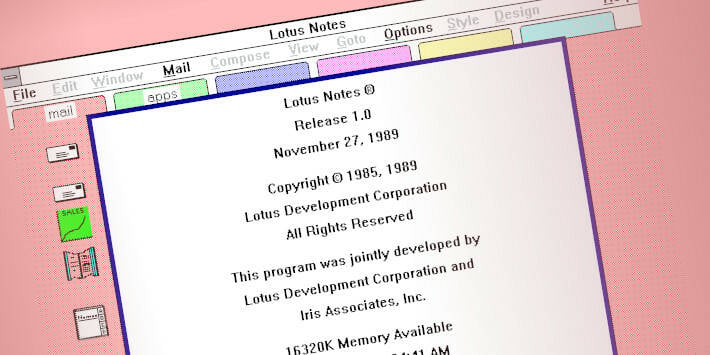Retro Tech Week It may seem that progress in technology proceeds in a linear fashion, with new developments replacing older ones. From this viewpoint, newer technology will always be better, since it is presumed to have built upon what came before it and improved on it.
Grow older, and you start to realize that this isn’t always the case. Progress doesn’t always go in a straight line. Just look at how personal computers largely replaced the hulking mainframes and minicomputers that came before them, then proceeded to slowly accumulate the advanced features of those older systems, like multi-user support, redundancy, and security.
There are also technologies that seemed ahead of their time, or which industry veterans may look back on with fondness because they offered something missing from our current world of high tech.
One of these is Lotus Notes, the mere mention of which is likely to draw derisory comments from readers because it certainly wasn’t without its faults; its resource-hungriness caused the program to be referred to as “Notice Loads” among some users, for example.
However, you could just about run an entire company on Lotus Notes (plus its Domino server back-end), and many did just that. The program was a weird combination of email, databases, and workflow that allowed companies to stand up custom applications and deploy them to relevant groups of workers inside Notes.
This writer worked for one publishing company that used Notes extensively, and I found it to be incredibly useful in its day. It provided not just your email, but an internal telephone directory, contact database, booking system for time off, company handbook, and more, all accessible via a single application and a single set of credentials, long before single sign-on became a thing.
Nowadays, it is common for most if not all of these functions to be delivered via separate web-based applications, each requiring a different login so you need to have dozens of different credentials, and each one sporting a different user interface. So I guess you could regard the web browser as an app runtime that is the ultimate successor to Notes?
If you wanted some idea of how useful Notes was, consider one of the apps this writer had access to in order to support my role as a reviews editor. The magazine (remember paper magazines? How quaint!) used to run about 30 pages of product reviews in every monthly issue, and we had a database on Notes to help keep track of everything.
40 years since Elite became the most fun you could have with 22 kilobytes
Eben Upton on Sinclair, Acorn, and the Raspberry Pi
How Sinclair’s QL computer outshined Apple’s Macintosh against all odds
What are our top picks from the vast world of retro tech? Let’s find out
Computer kit to be reviewed used to arrive at the publisher’s offices and would be given a serial code and logged in to a storeroom by a member of staff. As reviews editor, I would get a notification on Notes that it had arrived, so the reviewer could be told it was awaiting their pleasure, and I was able to add it to the table of products to appear in the magazine issue currently being worked towards.
The publisher’s internal photographer (this was the Nineties, when publishers had more money) had a view of the same table, so they knew which products to photograph for that issue. This workflow had been built internally, all on Lotus Notes. There were many similar applications that others in the company had access to.
Perhaps I have a rose-tinted view of Notes, but I recall it being quite easy to manage your emails thanks to a threaded view for email message chains, and it seemed a real retrograde step when I later worked for a company that used Outlook instead.
However, Notes had started to look somewhat clunky and dated by the turn of the millennium, and its considerable user base started to dwindle as corporates defected to the combination of Microsoft Exchange Server and Outlook, which were perhaps easier to integrate with Microsoft Office applications and Visual Basic for Applications when it came to workflows.
Eventually, IBM, which had acquired Lotus in 1995, announced in 2012 that it would be discontinuing the Lotus brand altogether, before offloading Notes to Indian software outfit HCL Technologies in 2018.
The platform still survives, with HCL releasing Domino 14.0 last year, which, as The Register commented at the time, speaks to the “stickiness” of the custom workflows built on the platform.
For those interested, one company has published a detailed history of Lotus Notes, from its beginnings to the current day.
But Notes is nowhere near holding the record for the oldest piece of software still being used. The US Defense Contract Management Agency (DCMA), which takes care of contracts for the Department of Defense (DoD), is said to have a program called Mechanization of Contract Administration Services (MOCAS), which was introduced in 1958, making it nearly twice as old. ®
>>> Read full article>>>
Copyright for syndicated content belongs to the linked Source : The Register – https://go.theregister.com/feed/www.theregister.com/2024/01/19/remembering_lotus_notes/































